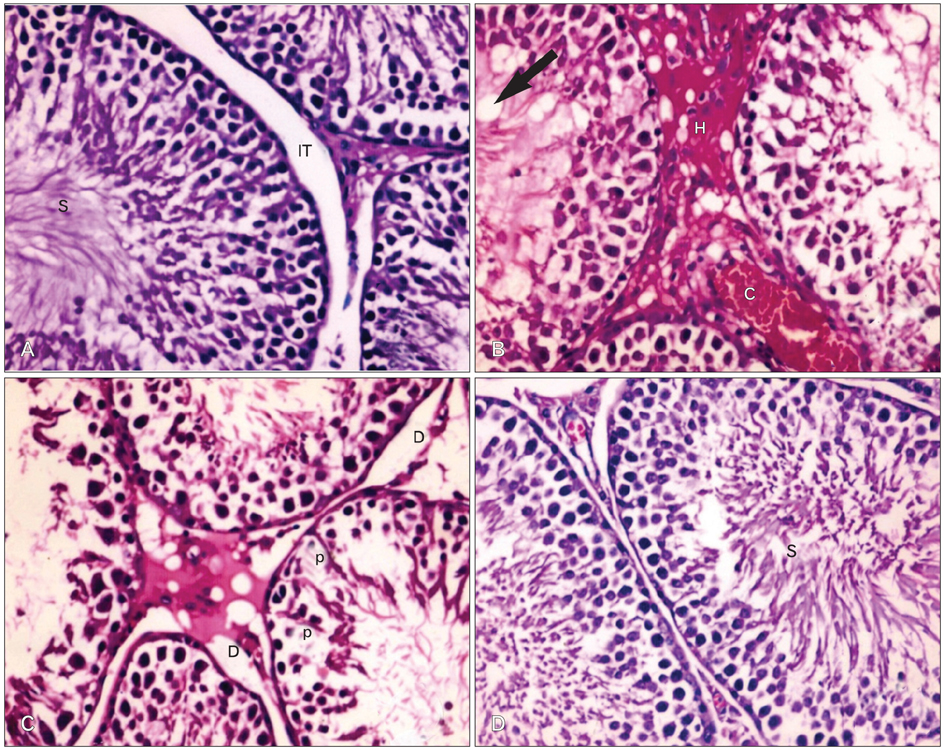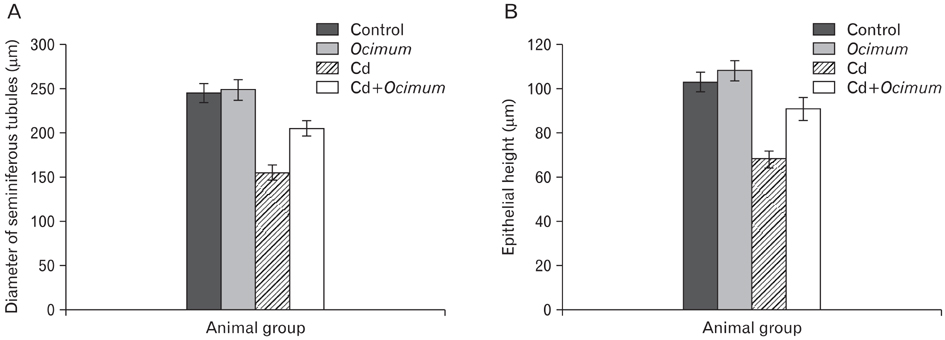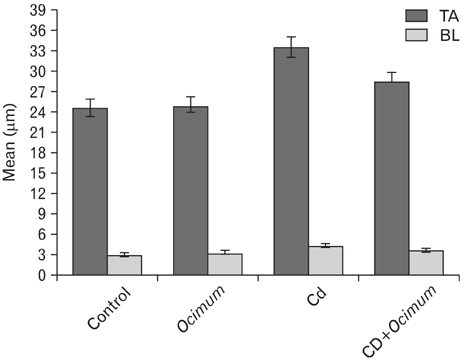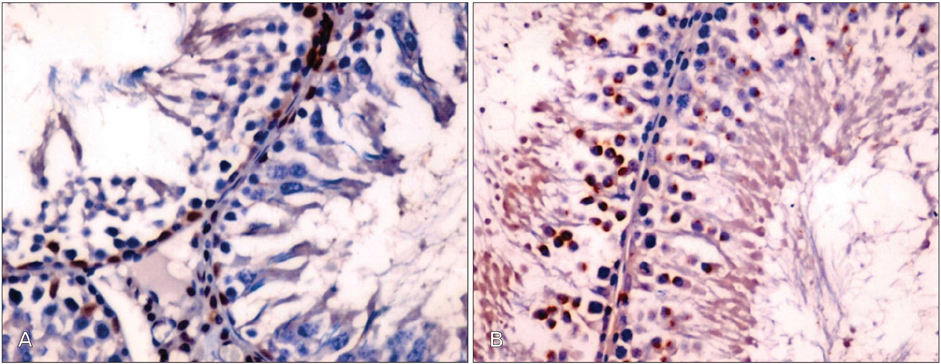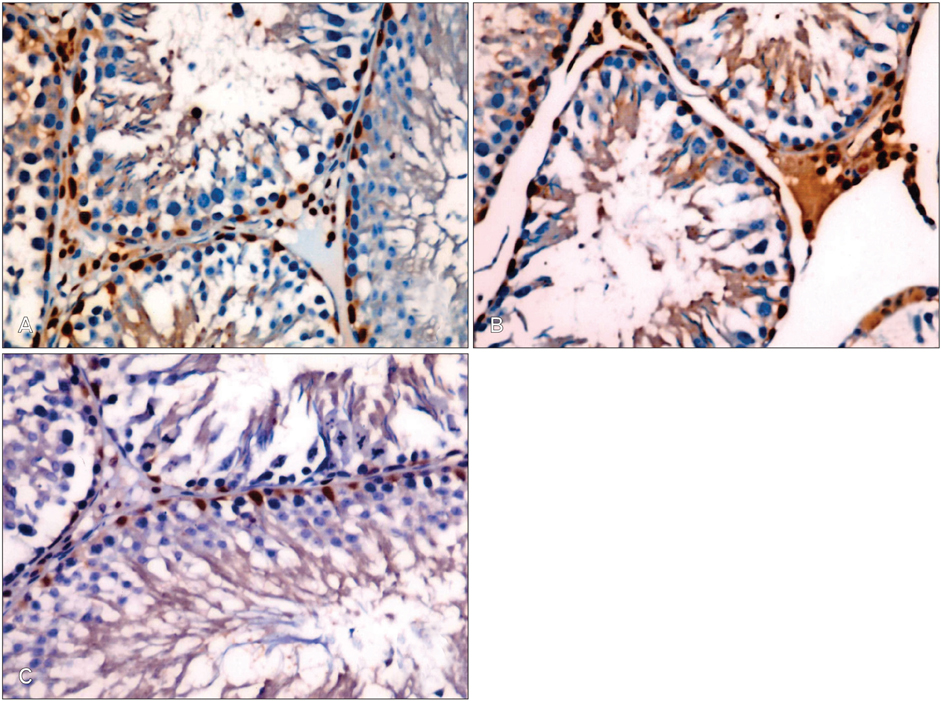Anat Cell Biol.
2013 Jun;46(2):122-130. 10.5115/acb.2013.46.2.122.
Effect of Ocimum basilicum extract on cadmium-induced testicular histomorphometric and immunohistochemical alterations in albino rats
- Affiliations
-
- 1Department of Zoology, Faculty of Science, Menoufia University, Shebin El-kom, Egypt. sabsak@yahoo.com
- 2Department of Anatomy and Embryology, Faculty of Medicine, Menoufia University, Shebin El-kom, Egypt.
- KMID: 2263104
- DOI: http://doi.org/10.5115/acb.2013.46.2.122
Abstract
- The present study examined the efficacy of Ocimum basilicum (basil) extract, a natural herb, with antioxidant properties, against testicular toxicity induced by cadmium (Cd), which is one of the most important toxic heavy metals. The intoxicated rats showed significant alterations in the testicular tissue including decreased seminiferous epithelium height and changes in the arrangement of spermatogenic layers. Hypospermatogensis with cytoplasmic vacuolization and pyknotic nuclei were observed. Intertubular hemorrahage and absence of spermatozoa were noted. Decreased cell proliferation was reflected by a decrease in Ki-67 expression, whereas the increase in apoptotic rate was associated with a decrease in the Bcl/Bax ratio. Concomitant treatment with aqueous basil extract led to an improvement in histological, morphometrical and immunohistochemical changes induced by Cd. The beneficial effects of basil extract could be attributed to its antioxidant properties.
MeSH Terms
Figure
Cited by 1 articles
-
Co-administration of alcohol and combination antiretroviral therapy (cART) in male Sprague Dawley rats: a study on testicular morphology, oxidative and cytokines perturbations
Elna Owembabazi, Pilani Nkomozepi, Tanya Calvey, Ejikeme Felix Mbajiorgu
Anat Cell Biol. 2023;56(2):236-251. doi: 10.5115/acb.22.229.
Reference
-
1. Brinkworth MH, Weinbauer GF, Schlatt S, Nieschlag E. Identification of male germ cells undergoing apoptosis in adult rats. J Reprod Fertil. 1995. 105:25–33.2. Furuchi T, Masuko K, Nishimune Y, Obinata M, Matsui Y. Inhibition of testicular germ cell apoptosis and differentiation in mice misexpressing Bcl-2 in spermatogonia. Development. 1996. 122:1703–1709.3. Richburg JH. The relevance of spontaneous- and chemically-induced alterations in testicular germ cell apoptosis to toxicology. Toxicol Lett. 2000. 112-113:79–86.4. Print CG, Loveland KL. Germ cell suicide: new insights into apoptosis during spermatogenesis. Bioessays. 2000. 22:423–430.5. Park HH, Lo YC, Lin SC, Wang L, Yang JK, Wu H. The death domain superfamily in intracellular signaling of apoptosis and inflammation. Annu Rev Immunol. 2007. 25:561–586.6. Waisberg M, Joseph P, Hale B, Beyersmann D. Molecular and cellular mechanisms of cadmium carcinogenesis. Toxicology. 2003. 192:95–117.7. Toman R, Golian J, Šiška B, Massányi P, Lukáč N, Adamkovičová M. Cadmium and selenium in animal tissues and their interactions after an experimental administration to rats. Slovak J Anim Sci. 2009. 42:Suppl 1. 115–118.8. Jarup L, Akesson A. Current status of cadmium as an environmental health problem. Toxicol Appl Pharmacol. 2009. 238:201–208.9. Eybl V, Kotyzová D. Protective effect of manganese in cadmium-induced hepatic oxidative damage, changes in cadmium distribution and trace elements level in mice. Interdiscip Toxicol. 2010. 3:68–72.10. Galazyn-Sidorczuk M, Brzóska MM, Jurczuk M, Moniuszko-Jakoniuk J. Oxidative damage to proteins and DNA in rats exposed to cadmium and/or ethanol. Chem Biol Interact. 2009. 180:31–38.11. Nava-Hernández MP, Hauad-Marroquín LA, Bassol-Mayagoitia S, García-Arenas G, Mercado-Hernández R, Echávarri-Guzmán MA, Cerda-Flores RM. Lead-, cadmium-, and arsenic-induced DNA damage in rat germinal cells. DNA Cell Biol. 2009. 28:241–248.12. Kim J, Soh J. Cadmium-induced apoptosis is mediated by the translocation of AIF to the nucleus in rat testes. Toxicol Lett. 2009. 188:45–51.13. Marettová E, Maretta M, Legáth J. Changes in the peritubular tissue of rat testis after cadmium treatment. Biol Trace Elem Res. 2010. 134:288–295.14. Manosroi J, Dhumtanom P, Manosroi A. Anti-proliferative activity of essential oil extracted from Thai medicinal plants on KB and P388 cell lines. Cancer Lett. 2006. 235:114–120.15. de Almeida I, Alviano DS, Vieira DP, Alves PB, Blank AF, Lopes AH, Alviano CS, Rosa Mdo S. Antigiardial activity of Ocimum basilicum essential oil. Parasitol Res. 2007. 101:443–452.16. Akujobi CO, Anyanwu BN, Onyeze GO, Ibekwe VI. Antibacterial activities and preliminary phytochemical screening of four medical plants. J Appl Sci. 2004. 7:4328–4338.17. Sethi J, Sood S, Seth S, Talwar A. Protective effect of Tulsi (Ocimum sanctum) on lipid peroxidation in stress induced by anemic hypoxia in rabbits. Indian J Physiol Pharmacol. 2003. 47:115–119.18. Harnafi H, Aziz M, Amrani S. Sweet basil (Ocimum basilicum L.) improves lipid metabolism in hypercholesterolemic rats. E Spen Eur E J Clin Nutr Metab. 2009. 4:181–186.19. Batra M, Gupta RP. Effects of Ocimum sanctum leaf on pathology and immune response in chickens experimentally infected with hydropericardium syndrome. Indian J Vet Pathol. 2006. 30:1–4.20. Sharma MK, Kumar M, Kumar A. Ocimum sanctum aqueous leaf extract provides protection against mercury induced toxicity in Swiss albino mice. Indian J Exp Biol. 2002. 40:1079–1082.21. Sood S, Narang D, Dinda AK, Maulik SK. Chronic oral administration of Ocimum sanctum Linn. augments cardiac endogenous antioxidants and prevents isoproterenol-induced myocardial necrosis in rats. J Pharm Pharmacol. 2005. 57:127–133.22. Rupert T. Cooking with fresh herbs and spices can boost immune systems, reduce cholesterol, and help protect against cancer. Med J Aust. 2009. 361:264–270.23. Sakr SA, El-Abd SF, Osman M, Kandil AM, Helmy MS. Ameliorative effect of aqueous leave extract of Ocimum basilicum on Ccl4-induced hepatotoxicity and apoptosis in albino rats. J Am Sci. 2011. 7:116–127.24. Ohta H, Yamauchi Y, Nakakita M, Tanaka H, Asami S, Seki Y, Yoshikawa H. Relationship between renal dysfunction and bone metabolism disorder in male rats after long-term oral quantitative cadmium administration. Ind Health. 2000. 38:339–355.25. Offiah VN, Chikwendu UA. Antidiarrhoeal effects of Ocimum gratissimum leaf extract in experimental animals. J Ethnopharmacol. 1999. 68:327–330.26. Lillie RD, Fulmer HM. Histopathological technique and practical histochemistry. 1976. 4th ed. New York: McGraw Hill.27. Al-Azemi M, Omu FE, Kehinde EO, Anim JT, Oriowo MA, Omu AE. Lithium protects against toxic effects of cadmium in the rat testes. J Assist Reprod Genet. 2010. 27:469–476.28. de Souza Predes F, Diamante MA, Dolder H. Testis response to low doses of cadmium in Wistar rats. Int J Exp Pathol. 2010. 91:125–131.29. Burukoğlu D, Bayçu C. Protective effects of zinc on testes of cadmium-treated rats. Bull Environ Contam Toxicol. 2008. 81:521–524.30. Blanco A, Moyano R, Vivo J, Flores-Acuña R, Molina A, Blanco C, Agüera E, Monterde JG. Quantitative changes in the testicular structure in mice exposed to low doses of cadmium. Environ Toxicol Pharmacol. 2007. 23:96–101.31. Ige SF, Olaleye SB, Akhigbe RE, Akanbi TA, Oyekunle OA, Udoh UA. Testicular toxicity and sperm quality following cadmium exposure in rats: ameliorative potentials of Allium cepa. J Hum Reprod Sci. 2012. 5:37–42.32. Zhang M, He Z, Wen L, Wu J, Yuan L, Lu Y, Guo C, Zhu L, Deng S, Yuan H. Cadmium suppresses the proliferation of piglet Sertoli cells and causes their DNA damage, cell apoptosis and aberrant ultrastructure. Reprod Biol Endocrinol. 2010. 8:97.33. Zhou T, Zhou G, Song W, Eguchi N, Lu W, Lundin E, Jin T, Nordberg G. Cadmium-induced apoptosis and changes in expression of p53, c-jun and MT-I genes in testes and ventral prostate of rats. Toxicology. 1999. 142:1–13.34. Xu G, Zhou G, Jin T, Zhou T, Hammarström S, Bergh A, Nordberg G. Apoptosis and p53 gene expression in male reproductive tissues of cadmium exposed rats. Biometals. 1999. 12:131–139.35. Sasaki K, Murakami T, Kawasaki M, Takahashi M. The cell cycle associated change of the Ki-67 reactive nuclear antigen expression. J Cell Physiol. 1987. 133:579–584.36. Falana BA, Ogundele OM, Duru FI, Oshinubi AA, Falode DT. Role of Se+Zn in regeneration (Ki-67) following Pb toxicity (p53and cad) in the germinal epithelium of adult Wistar rats. Pak J Biol Sci. 2013. 16:67–73.37. Ferrara D, Hallmark N, Scott H, Brown R, McKinnell C, Mahood IK, Sharpe RM. Acute and long-term effects of in utero exposure of rats to di(n-butyl) phthalate on testicular germ cell development and proliferation. Endocrinology. 2006. 147:5352–5362.38. Tremellen K. Oxidative stress and male infertility: a clinical perspective. Hum Reprod Update. 2008. 14:243–258.39. Turner TT, Lysiak JJ. Oxidative stress: a common factor in testicular dysfunction. J Androl. 2008. 29:488–498.40. Valko M, Morris H, Cronin MT. Metals, toxicity and oxidative stress. Curr Med Chem. 2005. 12:1161–1208.41. Beyersmann D, Hartwig A. Carcinogenic metal compounds: recent insight into molecular and cellular mechanisms. Arch Toxicol. 2008. 82:493–512.42. Sen Gupta R, Sen Gupta E, Dhakal BK, Thakur AR, Ahnn J. Vitamin C and vitamin E protect the rat testes from cadmium-induced reactive oxygen species. Mol Cells. 2004. 17:132–139.43. Szuster-Ciesielska A, Stachura A, Slotwińska M, Kamińska T, Sniezko R, Paduch R, Abramczyk D, Filar J, Kandefer-Szerszeń M. The inhibitory effect of zinc on cadmium-induced cell apoptosis and reactive oxygen species (ROS) production in cell cultures. Toxicology. 2000. 145:159–171.44. Khaki A, Fathiazad F, Nouri M, Khaki AA. Effect of Ocimum basilicum on apoptosis in testis of rats after exposure to electromagnetic field. Afr J Pharm Pharmacol. 2011. 5:1534–1537.45. Asuquo OR, Edet AG, Mesembe O, Atanghwo JI. Ethanolic extracts of Vernonia amygdalina and Ocimum gratissimum enhance testicular improvement in diabetic Wistar rats. Internet J Altern Med. 2010. 8:http://dx.doi.org/10.5580/89d.46. Khuon OS. Pharmacological effect of aqueous leaves extract of Ocimum basilicum against liver toxicity induced by acetaminophen in male rats. Thi-Qar J Agric Res. 2012. 1:13–28.47. Zhang JW, Li SK, Wu WJ. The main chemical composition and in vitro antifungal activity of the essential oils of Ocimum basilicum Linn. var. pilosum (Willd.) Benth. Molecules. 2009. 14:273–278.48. Neradil J, Veselská R, Slanina J. UVC-protective effect of caffeic acid on normal and transformed human skin cells in vitro. Folia Biol (Praha). 2003. 49:197–202.49. Yeh CT, Yen GC. Effects of phenolic acids on human phenolsulfotransferases in relation to their antioxidant activity. J Agric Food Chem. 2003. 51:1474–1479.50. Dasgupta T, Rao AR, Yadava PK. Chemomodulatory efficacy of basil leaf (Ocimum basilicum) on drug metabolizing and antioxidant enzymes, and on carcinogen-induced skin and forestomach papillomagenesis. Phytomedicine. 2004. 11:139–151.51. Meera R, Devi P, Kameswari B, Madhumitha B, Merlin NJ. Antioxidant and hepatoprotective activities of Ocimum basilicum Linn. and Trigonella foenum-graecum Linn. against H2O2 and CCL4 induced hepatotoxicity in goat liver. Indian J Exp Biol. 2009. 47:584–590.
- Full Text Links
- Actions
-
Cited
- CITED
-
- Close
- Share
- Similar articles
-
- Development of an effective formulation for an acne treatment cream with Ocimum basilicum using invasomes
- Effect of saffron (Crocus sativus L.) on sodium valporate induced cytogenetic and testicular alterations in albino rats
- Ethanol extract of aloe vera ameliorates Artemether-Lumefantrine-induced reproductive toxicity in adult male Albino rats (Wistar Strain)
- Effect of Cadmium Chloride on the Cardiac Muscle Ultrastructure in Rats
- Mast Cell Degranulation with Special Reference to the Effect of a Saponin Extract of Ginseng upon the Mesenteric Mast Cell of Albino Rats

